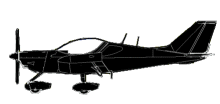
ASN Wikibase Occurrence # 165989
This information is added by users of ASN. Neither ASN nor the Flight Safety Foundation are responsible for the completeness or correctness of this information.
If you feel this information is incomplete or incorrect, you can submit corrected information.
| Date: | Sunday 4 May 2014 |
| Time: | 09:30 |
| Type: |  CSA PiperSport |
| Owner/operator: | Private |
| Registration: | N162US |
| MSN: | P1102014 |
| Year of manufacture: | 2011 |
| Total airframe hrs: | 1157 hours |
| Engine model: | Rotax 912 |
| Fatalities: | Fatalities: 0 / Occupants: 1 |
| Aircraft damage: | Substantial |
| Category: | Accident |
| Location: | ENE of Sugar Valley Airport (5NC2), Mocksville, NC -
 United States of America United States of America
|
| Phase: | Landing |
| Nature: | Private |
| Departure airport: | Mocksville, NC (5NC2) |
| Mocksville, NC (5NC2) | |
| Investigating agency: | NTSB |
| Confidence Rating: |
According to the pilot, about 45 minutes into the local flight and after reducing engine power for the descent, the engine rpm began to decrease. She applied carburetor heat in an attempt to regain full engine power; however, the engine rpm continued to decrease, and the engine then lost total power. She unsuccessfully attempted to restart the engine, performed the emergency engine shutdown procedures, and then chose to land the airplane in a field, during which it sustained substantial damage to the firewall, fuselage, and right wing.
A postaccident examination of the airframe revealed no anomalies that would have precluded normal operation. The engine was test run and examined about 4 months after the accident. The engine was initially test run using alternate fuel with no anomalies noted. The engine was then test run using fuel found in the left wing tank. During that test run, the engine hesitated, but it did not lose total power. The fuel recovered from the airplane was tested, and it did not meet the specification limits for automotive gas, aviation gas, or UL82 aviation gas; however, it did exhibit characteristics of evaporated automotive gas. Although a white powdery substance was found in the carburetor and the fuel did not meet specifications, due to the amount of time that passed between the accident and the engine examination, it could not be determined whether the powdery substance was in the carburetor, or what the fuel condition was, when the engine lost power.
Weather conditions at the time of the accident were conducive to the accumulation of serious carburetor icing at glide power, and carburetor icing is more likely to form when an engine is operating on automotive gas. In addition, the Pilot’s Operating Handbook noted that carburetor heat should be used during descents. Therefore, it is likely that the pilot’s delayed application of carburetor heat during the descent resulted in a total loss of engine power due to carburetor icing.
Probable Cause: The pilot’s failure to apply carburetor heat during a descent with reduced engine power while operating in conditions conducive to carburetor icing, which resulted in a total loss of engine power.
Accident investigation:
 |
|
Sources:
NTSB
FAA register: http://registry.faa.gov/aircraftinquiry/NNum_Results.aspx?NNumbertxt=162US
Location
Revision history:
| Date/time | Contributor | Updates |
|---|---|---|
| 04-May-2014 18:30 | Geno | Added |
| 05-May-2014 01:27 | Geno | Updated [Source] |
| 08-May-2014 19:54 | Geno | Updated [Time, Phase, Nature, Source, Narrative] |
| 18-Jan-2016 10:09 | Anon. | Updated [Damage] |
| 21-Dec-2016 19:28 | ASN Update Bot | Updated [Time, Damage, Category, Investigating agency] |
| 29-Nov-2017 14:22 | ASN Update Bot | Updated [Other fatalities, Departure airport, Destination airport, Source, Narrative] |
Corrections or additions? ... Edit this accident description
The Aviation Safety Network is an exclusive service provided by:


 ©2024 Flight Safety Foundation
©2024 Flight Safety Foundation